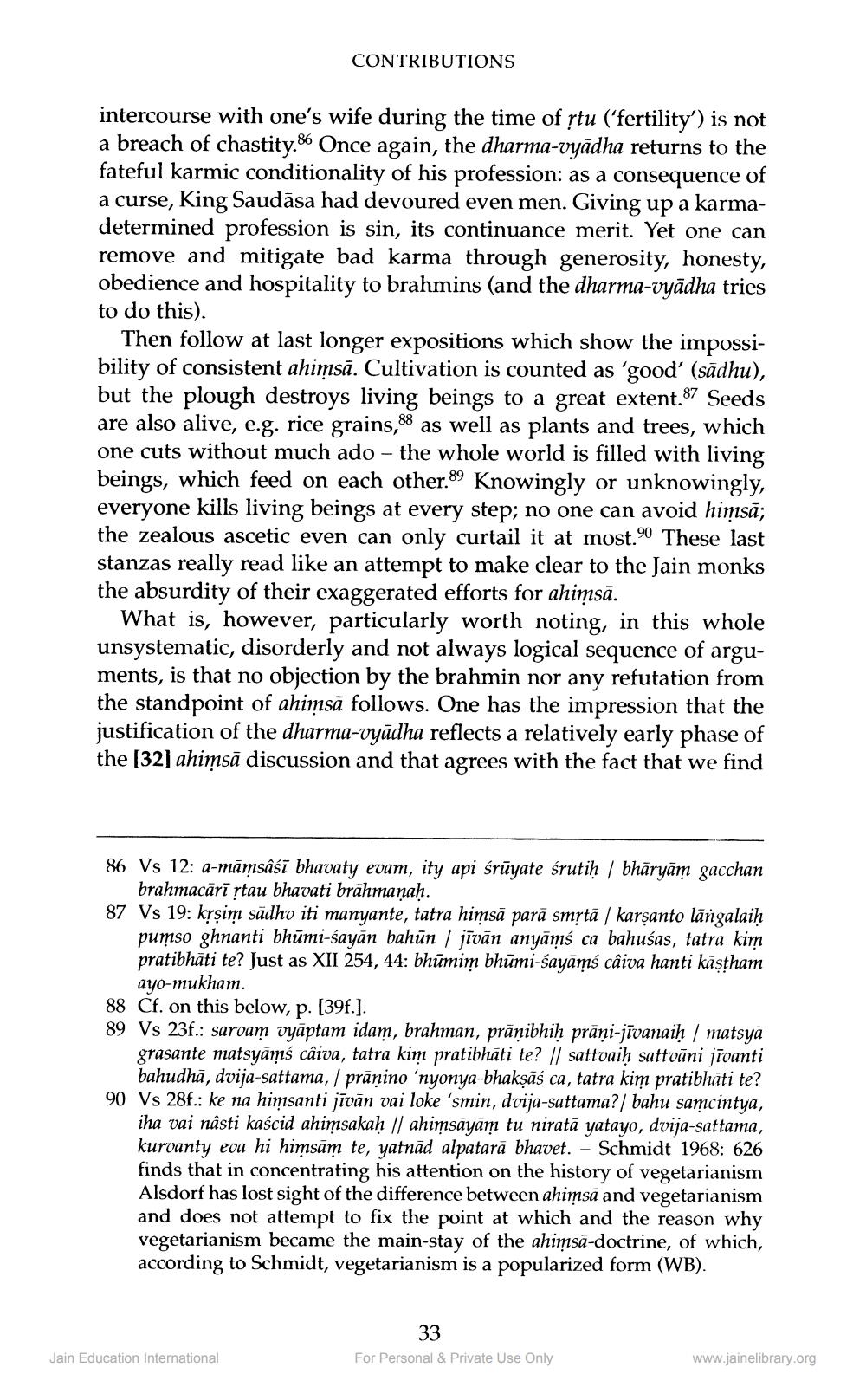________________
CONTRIBUTIONS
intercourse with one's wife during the time of stu ('fertility') is not a breach of chastity.86 Once again, the dharma-vyādha returns to the fateful karmic conditionality of his profession: as a consequence of a curse, King Saudāsa had devoured even men. Giving up a karmadetermined profession is sin, its continuance merit. Yet one can remove and mitigate bad karma through generosity, honesty, obedience and hospitality to brahmins (and the dharma-vyādha tries to do this).
Then follow at last longer expositions which show the impossibility of consistent ahiņsā. Cultivation is counted as 'good' (sādhu), but the plough destroys living beings to a great extent.87 Seeds are also alive, e.g. rice grains,88 as well as plants and trees, which one cuts without much ado - the whole world is filled with living beings, which feed on each other.89 Knowingly or unknowingly, everyone kills living beings at every step; no one can avoid himsā; the zealous ascetic even can only curtail it at most.90 These last stanzas really read like an attempt to make clear to the Jain monks the absurdity of their exaggerated efforts for ahimsā.
What is, however, particularly worth noting, in this whole unsystematic, disorderly and not always logical sequence of arguments, is that no objection by the brahmin nor any refutation from the standpoint of ahimsā follows. One has the impression that the justification of the dharma-vyādha reflects a relatively early phase of the [32] ahimsā discussion and that agrees with the fact that we find
86 Vs 12: a-māmsâśī bhavaty evam, ity api śrūyate śrutih / bhāryām gacchan
brahmacārī rtau bhavati brāhmanah. 87 Vs 19: krşim sadhv iti manyante, tatra himsā parā smrtā / karşanto lāngalaiḥ
pumso ghnanti bhūmi-śayān bahūn / jīvān anyāmś ca bahuśas, tatra kim pratibhāti te? Just as XII 254, 44: bhūmim bhūmi-śayāmś câiva hanti kastham
ayo-mukham. 88 Cf. on this below, p. [39f.). 89 Vs 23f.: sarvam vyāptam idam, brahman, prāņibhiḥ prani-jīvanaih / matsyā
grasante matsyāmś câiva, tatra kim pratibhāti te? // sattvaih sattvāni jīvanti
bahudhā, dvija-sattama, / pranino 'nyonya-bhaksāś ca, tatra kim pratibhāti te? 90 Vs 28f.: ke na himsanti jīvān vai loke ‘smin, dvija-sattama?/ bahu samcintya,
iha vai nâsti kaścid ahimsakah // ahimsāyām tu niratā yatayo, dvija-sattama, kurvanty eva hi himsām te, yatnād alpatarā bhavet. - Schmidt 1968: 626 finds that in concentrating his attention on the history of vegetarianism Alsdorf has lost sight of the difference between ahimsā and vegetarianism and does not attempt to fix the point at which and the reason why vegetarianism became the main-stay of the ahimsa-doctrine, of which, according to Schmidt, vegetarianism is a popularized form (WB).
33 For Personal & Private Use Only
Jain Education International
www.jainelibrary.org




